Ammonia-oxidizing archaea and bacteria
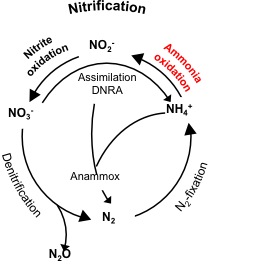
Ammonia oxidation is a key step in the biogeochemical nitrogen cycle and is producing nitrite for nitrite-oxidizing or nitrite-reducing microbes. This process is of major importance for nitrogen cycling in the environment and a central step in efficient wastewater treatment, but also strongly contributes to fertilizer loss and N2O formation in agriculture. Microbial ammonia oxidation has been intensively investigated for decades, but until recently only two bacterial groups within the Proteobacteria were known to aerobically thrive on ammonia as substrate for growth. During the last decade it became apparent that members of the archaeal phylum Thaumarchaeota are also capable of ammonia-oxidation for energy generation. My lab investigates the evolution, physiology, and ecology of ammonia-oxidizing microbes. Our efforts in this field, that were also strongly supported by the ERC Advanced Grant project Nitricare, range from pure culture physiological studies to advanced single cell genomics approaches.
Recent projects:
We have obtained an enrichment of the ammonia-oxidizing thaumarchaeote Nitrososphaera gargensis and have analyzed this moderately thermophilic strain genomically (Spang et al., 2012). Interestingly, it produces F420 as a cofactor and has a more flexible central carbon metabolism than expected. In the meantime we succeeded in obtaining a pure culture of this strain. We are currently analysing the structure and function of its F420.
Now working on this theme: Chris Sedlaceck. Previously working on this theme: Roland Hatzenpichler, Alexander Galushko, Márton Palatinszky. Collaboration partner: Elena Lebedeva (Russian Academy of Sciences), Chris Greening (Monash University, Australia)
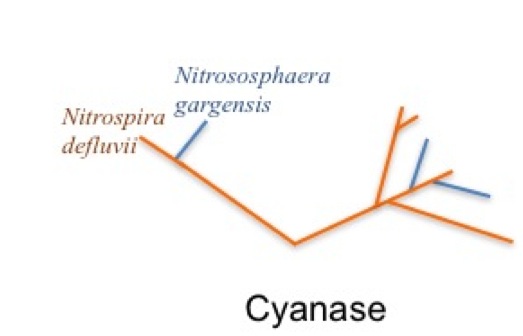
We recently demonstrated that N. gargensis is the first known organisms that can grow on cyanate as sole source of energy and reductant. While many other ammonia-oxidizers lack this capability, all genome-sequenced nitrite-oxidizers possess a cyanase for conversion of cyanate to ammonium and CO2. Using co-culture experiments we showed that cyanase-positive nitrite-oxidizers can team up with cyanase-negative ammonia oxidizers to enable growth of both partners on cyanate. This new type of interaction between nitrifiers via reciprocal feeding also showed that the first step in nitrification can in some cases be performed by nitrite-oxidizers (Palatinszky et al. 2015, Nature). Furthermore, we demonstrated that reciprocal feeding of nitrifiers also occurs with urea as substrate (Koch et al. 2015, PNAS). Interestingly, we could recently demonstrate cyanate conversion as a source of energy and nitrogen for marine thaumarchaeotes in the Gulf of Mexico that do not encode a canonical cyanase (Kitzinger et al. 2019).
Now working on this theme: Katharina Kitzinger (previously Alexander Galushko, Márton Palatinszky, Ping Han, Mario Pogoda, Maria Mooshammer)
Collaboration partners: Marcel Kuypers (MPI Bremen, Germany), Nico Jehmlich, Martin van Bergen (UFZ, Leipzig, Germany)
In collaboration with Yujie Men and Kathrin Fenner from the EAWAG in Switzerland we investigate micropollutant degradation by ammonia-oxidizing bacteria and archaea.
Previously working on this theme: Ping Han
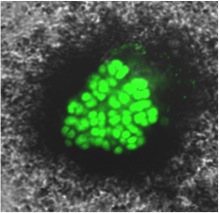
We have shown that close relatives of N. gargensis in an industrial wastewater treatment plant encode and express amoA, but obtain their energy from substrates other than ammonia (Mussman et al. 2011, PNAS). Using single-cell, cultivation and meta-omic techniques we are characterizing thauamarchaeotes in various municipal and industrial wastewater treatment plants to better understand (i) their contribution to nitrification in these systems and (ii) their physiological versatility.
Now working on this theme: Julia Vierheilig.
Collaboration partners: Josh Neufeld and Laura Sauder (University of Waterloo, Canada), and Ian Head (Newcastle, Uk)
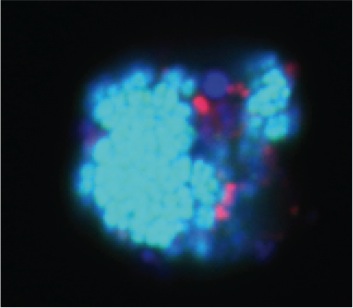
We investigate the diversity of ammonia-oxidizing microbes in wastewater treatment plants by single microcolony isotope labeling, subsequent Raman sorting and single microcolony genomics. As closely attached interaction partners of the ammonia-oxidizers are also sorted, this approach does not only reveal genomic information of the active members of this guild, but also enables genomic characterization of nitrifier interaction partners in the wilderness. This project is supported by an ETOP- and a CSP-project of the JGI and is performed in collaboration with Tanja Woyke.
In order to establish an encompassing framework for comparative genomics of sorted ammonia oxidizers, we are currently sequencing the genomes of many cultures strains of this guild. This project is performed in collaboration with Andreas Pommerening-Röser (University of Hamburg, Germany) and Tanja Woyke from the JGI (Walnut Creek, USA).
Now working on this theme: Márton Palatinszky, Craig Herbold (previously Tae Kwon Lee, Esther Mader, Adrian Berger, Julius Simonis)
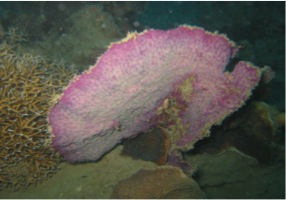
My group has a long-standing interest in the interaction of marine sponges with their microbial symbionts (Hentschel et al. 2002, Taylor et al. 2007, Webster et al. 2010). Using Ianthella basta from the Great Barrier Reef in Australia as model sponge we investigate by metagenomics, metaproteomics, and isotope labeling techniques the physiological interaction between this sponge and its symbionts. In contrast to many other sponges, I. basta harbors only three abundant symbionts and one of them is an ammonia-oxidizing member of the Thaumarchaeotes. This project has been supported by the Marie Curie International Training Networks Symbiomics.
Now working on this theme: Florian Moeller
Collaboration partners: Nicole Webster (AIMS, Australia), Thomas Schweder, Stephanie Markert (University of Greifswald, Germany), Mads Albertsen, Per Nielsen (Aalborg University, Denmark), Thomas Rattei, and Andreas Richter (University of Vienna, Austria)
Selected publications on this theme:
Hatzenpichler R, Lebedeva EV, Spieck E, Stoecker K, Richter A, Daims H, Wagner M. 2008. A moderately thermophilic ammonia-oxidizing crenarchaeote from a hot spring. Proc. Natl. Acad. Sci. USA 105: 2134-2139.
Kitzinger K, Padilla CC, Marchant HK, Hach PF, Herbold CW, Kidane AT, Könneke M, Littmann S, Mooshammer M, Niggemann J, Petrov S, Richter A, Stewart FJ, Wagner M, Kuypers MMM, Bristow LA. 2019. Cyanate and urea are substrates for nitrification by Thaumarchaeota in the marine environment. Nat Microbiol, 2: 234-243
Koch H, Lücker S, Albertsen M, Kitzinger K, Herbold C, Spieck E, Nielsen PH, Wagner M, Daims H. 2015. Expanded metabolic versatility of ubiquitous nitrite-oxidizing bacteria from the genus Nitrospira. Proc Natl Acad Sci U S A, 112: 11371-11376.
Mußmann M, Brito I, Pitcher A, Damsté JSS, Hatzenpichler R, Richter A, Nielsen JL, Nielsen PH, Müller A, Daims H, Wagner M, Head IM. 2011. Thaumarchaeotes abundant in refinery nitrifying sludges express amoA but are not obligate autotrophic ammonia oxidizers. Proc. Natl. Acad. Sci. USA 108: 16771-16776.
Palatinszky M, Herbold C, Jehmlich N, Pogoda M, Han P, von Bergen M, Lagkouvardos I, Karst SM, Galushko A, Koch H, Berry D, Daims H, Wagner M. 2015. Cyanate as an energy source for nitrifiers. Nature 524:105-108.
Pester M, Schleper C, Wagner M. 2011. The Thaumarchaeota: An Emerging View of their Phylogeny and Ecophysiology. Curr. Opin. Microbiol. 14: 300-306.
Pester M, Rattei T, Flechl S, Gröngröft A, Richter A, Overmann J, Reinhold-Hurek B, Loy A, Wagner M. 2012. amoA-based consensus phylogeny of ammonia-oxidizing archaea and deep sequencing of amoA genes from soils of four different geographic regions. Environ. Microbiol. 14: 525-539.
Spang A, Poehlein A, Offre P, Zumbrägel S, Haider S, Rychlik N, Nowka B, Schmeisser C, Lebedeva EV, Rattei T, Böhm C, Schmid M, Galushko A, Hatzenpichler R, Weinmaier T, Daniel R, Schleper C, Spieck E, Streit W, Wagner M. 2012. The genome of the ammonia-oxidizing Candidatus Nitrososphaera gargensis: Insights into metabolic versatility and environmental adaptations. Environ. Microbiol. 14: 3122-45.
